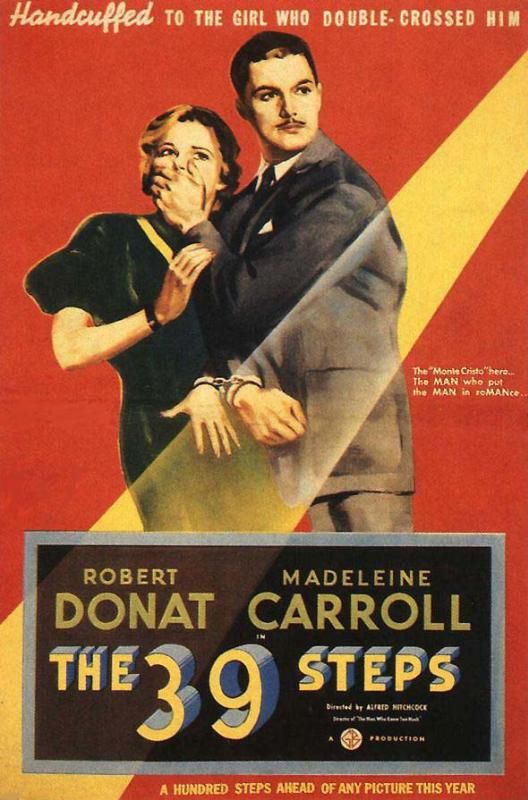 |
| This was clearly an early poster - notice the lack of advertising for Hitchcock's name. |
The
39 Steps
1935
Director: Alfred Hitchcock
Starring: Robert Donnat, Madeleine
Carroll
Alfred
Hitchcock is known as the Master of Suspense, everyone knows that. But what does that mean for a modern viewer
delving into his works? It means that in
a film from 1935, only seven years after talkies hit Hollywood, Hitchcock
produced a truly riveting, suspenseful film that nonetheless contains a sense
of fun comedy as well. That is, classic
Hitchcock.
Our
main character is Hannay (Donat), a Canadian vacationing in England, who goes
out to the music hall one night. A
gunshot rings out through the crowded hall.
In the mad rush out, a mysterious, beautiful woman with an accent asks
him to take her home. She’s a spy, and
when she is murdered in his apartment in the middle of the night, he is blamed
for her murder. He takes on her mission
for the good of England while trying to evade both enemy spies and omnipresent
policemen. What emerges is a mad chase
from London to Scotland and back again, during the course of which he falls in
with cool blonde Pamela (Carroll) who makes things infinitely more difficult.
The
39 Steps
is first and foremost a suspense film, and it’s very well done in this
regard. Hitchcock is clever in how he
ratchets up the tension throughout the film.
In the first half, when Hannay is running to Scotland, the sense of him
being pursued is derived from the major forms of mass communication, mostly the
newspaper. Hannay is constantly trying
to evade newspapers. At first, some
silly lingerie salesmen he shares a train compartment with are nattering about
the murder of the lady spy because they have read it in the paper. Do they suspect him? Suddenly their silliness seems menacing. Hannay escapes to a country croft in
Scotland, but the crofter takes the paper, and he worries again; will they turn
him in? Friends become foes, and police
are always nipping at Hannay’s heels.
There are more close scrapes than you can shake a stick at. It’s a tremendously suspenseful film; not,
perhaps, in the modern cinematic sense, but for a film from the 1930s, it’s
absolutely crackerjack.
The
39 Steps
is also significant in establishing so many traits we associate with
Hitchcock. It’s the first time Hitchcock
fully delved into a story about “The Wrong Man,” a theme he returned to again
and again in his later works. Hannay has
to be clever in order to fight against his unjust persecution. We also have the police as enemies, not as
friends, another major Hitchcockian thematic element. This is played out so fully in The 39 Steps
that you’ll worry far less about the bad guys catching Hannay than the cops
catching Hannay. Hitchcock even gives us
cops flat out lying to Hannay, pretending to believe his story of innocence
then turning around and arresting him.
While the police are not evil in the traditional sense, they clearly
cannot be trusted either. The plot
device that drives the film – seeking out “the 39 steps” because it’s some
impressive spy secret that’s necessary to save England – is a huge MacGuffin. It hardly matters by the end of the film what
“the 39 steps” are; all that matters is that it caused our hero to go on the
run. We even have our blonde female,
cold, a little cruel and a little sexy all at once. I know Hitchcock made a fairly large number
of films before this one, and I’ve seen some of them, but in my rather
uneducated opinion, this is the first Hitchcock movie that is thoroughly and
completely Hitchcockian in nature. It’s
the first time he fully realized what he was all about in terms of story,
devices, cinematography, and dialogue.
In fact, an argument could be made that North by Northwest, when
you boil it down, is essentially a remake of The 39 Steps but with a
bigger budget and better technology.
This is not a knock at North by Northwest, not at all, but
the same ideas that course through its veins are here in The 39 Steps as well.
Hitchcock
was always an innovator, but he concealed it by producing films with mass
market appeal. Throughout his career,
however, he would always dabble with the experimental, finding ways to make his
films using alternate techniques. The
39 Steps is a classic example of this.
Sound was still relatively new, so there is no traditional music
soundtrack in The 39 Steps, but Hitchcock is smart in his use of sound
effects. Just after our mysterious lady
spy has been killed, the phone rings.
There is no swelling of violins in the background (Bernard Herrmann
would come later), but it’s not needed, not with the incessant ringing of the
phone. The ring takes on a sinister
sound as we start to believe it’s the bad guys come to finish off Hannay as
well. When we later see the mysterious
spy’s face superimposed over a shot of the men we think are after her, again we
have Hitchcock playing around with film techniques. Furthermore, there is definitely a play of light
and shadow, perhaps from the influence of German Expressionism, that later
turned into the films from Hitchcock’s oeuvre that are most definitely films
noir.
There
is a sly sense of sexiness that makes The 39 Steps still feel juicy
today. The film was made in England so
there was no Hays Code, but Hitchcock would have still had to play by its rules
in order to get distribution in the States.
That being said, like so many films of the time, Hitchcock found a way
around its strictures to get a little racy.
There are the obvious aforementioned lingerie salesmen who unblushingly
produce undergarments from their briefcase, right before they start telling
dirty limericks. A priest glances a
little too long at said some lingerie.
Hannay has to pretend to be having an illicit affair in order to sneak
out of his flat, and later, throws the police off his track by making out with
Pamela by means of an introduction. The
country crofter who gives Hannay a bed immediately suspects that he is making
eyes at his young pretty wife. And
lastly, much of Hannay and Pamela’s interaction comes with the two of them
being literally handcuffed to each other, so the sly, tongue-in-cheek
suggestions as to how they spent the night together become a bit salacious
(watch how she takes her stockings off, then go get a glass of ice water),
despite the fact that nothing is shown.
It’s all about hinting at all the sexuality without really seeing
anything.
I
love the chemistry between Madeleine Carroll, the cool blonde, and Robert
Donnat. Pamela wholly believes that
Hannay is a murderer, and when she winds up handcuffed to him, things get
interesting. It’s at this point that the
picture turns from a nonstop thrill ride to a romance under unlikely
circumstances. The formula of a
bickering pair turned romantic pair is one of which I will never tire when done
well, and Hitchcock does it well. A
particular favorite scene of mine is when Donnat, tired of trying to convince
her of his innocence, starts to tell Carroll the tall tales of his “life as a
murderer.” He rattles it off with such
an exasperated coolness that she starts giggling. Who wouldn’t?
There
is a delicious sense of a full-circle in this film with Hannay’s game of cat
and mouse taking him from a music hall in London to the moors of Scotland, then
back to a crowded hall in London. It
gives a sense of completeness that is very satisfying. Overall, The 39 Steps is a wonderful romantic
romp, a suspenseful thriller, and a great adventure. For me, I have a soft spot for it because I
saw it in my first month of watching films from the 1001 Movies list,
and it truly impressed me. I still
remember watching it for the first time and getting completely caught up in the
suspenseful adventure, literally dropping my jaw on more than one
occasion. It’s a little primitive, but
no more so than any other film from the thirties, and more advanced than most
of its counterparts. Most of all,
though, this is a fully realized Hitchcock film.
Arbitrary
Rating: 9/10. A sentimental favorite.
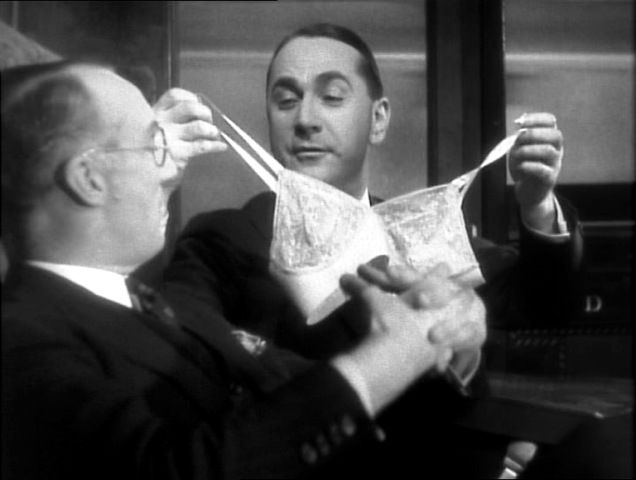
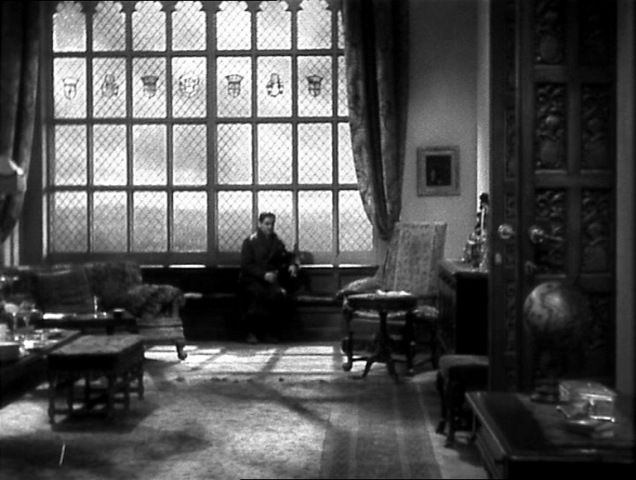
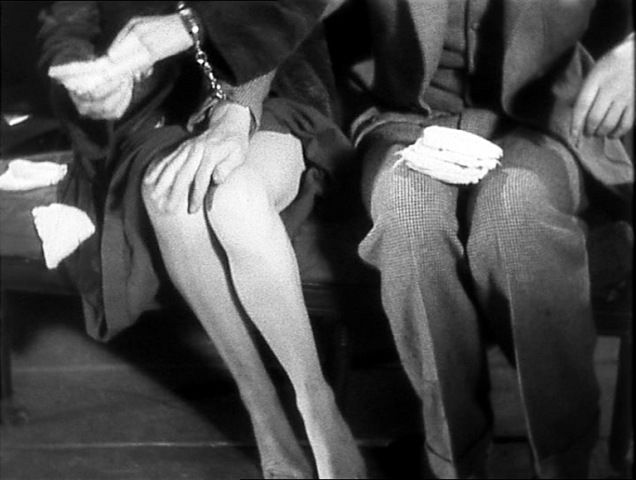
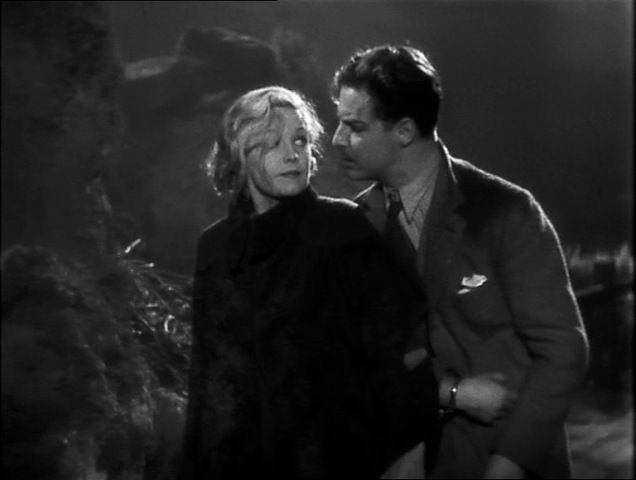
When I reviewed this, I called it the "beginner version of North by Northwest," which I think it is. It's the same spy stuff and the same mistaken identity stuff. It's just a lot more formulaic and simpler. It feels like verification to have you spot the same simplified version of the more famous plot.
ReplyDeleteBut, I also agree it's a real Hitchcock film. It's a fully realized film, and it's recognizable as one of his films. It shows the promise he eventually grew into, even if it doesn't get all the way there.
Oh, I'm so glad you agree re: NxNW, because I know you love that one. I feel like this is Hitchcock's "first pass" at North by Northwest. Sure, there's a bit of roughness around the edges, but it's still there.
DeleteFrom the early Hitchcock I've seen, which is only the stuff in 1001 Movies, The 39 Steps honestly feels like his first fully grown piece. Everything is there, everything that we know him for is in this movie, which isn't true of films like Blackmail.
I had promised myself to wait reading your review till I had made my own comments, but damn it your reviews are too good to miss. I entirely agree all along and consider this the best of Hitchcocks British productions by far. Not until Rebecca did he make a film as complete as 39 Steps. The fugitive theme works tremendously well all the way through and we are always uncertain who he can trust and more commonly who he cannot.
ReplyDeleteMaybe I should just copy your reveiw...
You flatter me, and thank you. Yes, Rebecca is definitely Hitchcock's next pinnacle, and yes, absolutely, The 39 Steps stands out from his pack of early films. His other real early British works are interesting, but not gripping, not wholly entertaining. The 39 Steps IS. It IS a fun joyride, it's completely realized, it's everything we want from a classic Hitchcock story.
DeleteI agree that this film had a lot of suspense in it. Unfortunately, it only succeeded in giving me a major letdown when we finally find out what "the 39 steps" actually are. My reaction was "that's it?" To be fair, the mystery had been built up so much that it's possible that no answer would have lived up to the hype. When I was doing my Movies by the Numbers categories a while back I would have settled for this film for the number 39, but I sought out other films that I might write about instead and I ended up finding one I preferred (and that is even in the tradition of Hitchcock - Glorious 39).
ReplyDeleteSee, it was never about "the 39 steps" for me. Who cares? I was far more interested in the chase; it didn't matter WHY Hannay was on the run, just that he WAS on the run. Classic Macguffin (but I do agree that what "the 39 steps" actually are is fairly pointless/a letdown if you've been looking forward to finding out).
DeleteThis movie confused me so much, but your post really cleared up a lot of things for me. Thanks! I was also only concerned with what the "39 steps" were so that probably was my problem.
ReplyDeleteHa ha, yeah, if you try to follow the mystery, it can get confusing. But I don't think "The 39 Steps" is really about the mystery. It's about the thrill of the chase instead.
DeleteEspecially with film noir (a genre of movies that is about SO much more than story!), I always like to watch a movie at least twice; the first time, I sit there and try to follow the plot. But once I know the plot, I can watch the film a second time focusing on other things - performances, score, tone, particular lines of dialogue, etc, all those other great things besides plot.
Thanks for the comment!
jordan shoes
ReplyDeletemichael kors handbags
skechers shoes
yeezy boost 350
links of london
louboutin shoes
longchamp handbags
michael kors handbags
nike polo shirts
chrome hearts
cheap jordans
ReplyDeletechristian louboutin outlet
michael kors outlet
lebron shoes
air max 97
balenciaga shoes
kyrie 6 shoes
longchamp handbags
golden goose
nike air max
official statement find out try here read the full info here Continued his explanation
ReplyDelete